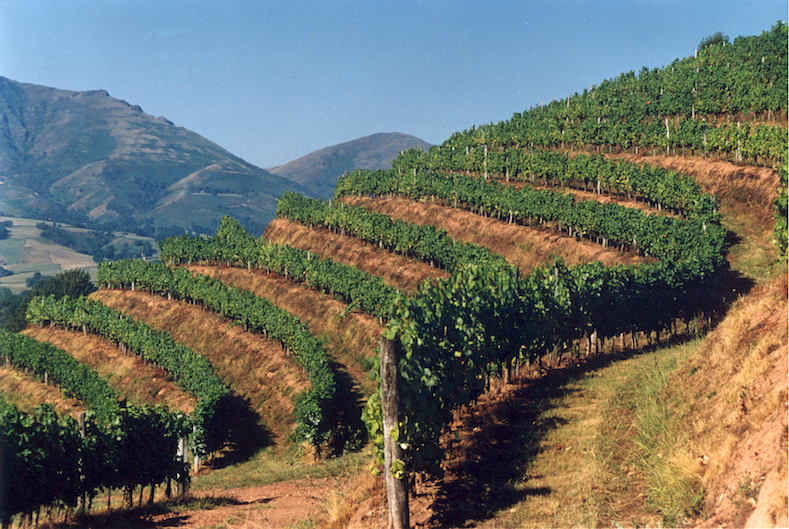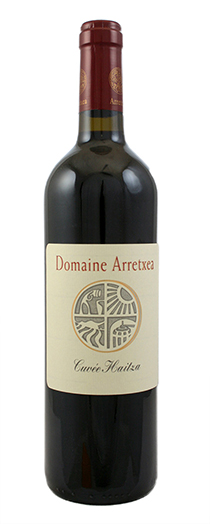
Michel Riouspeyrous is a native Basque. He met his Alsatian future wife Thérèse while on a charity mission to Africa. On their return to France, they got married and decided to start their own domaine by renting two hectares of vineyards. Domaine Arretxea was born in 1989. Arretxea (from the Basque arre meaning stone and xea house) is a small six-hectare domaine entirely planted on south-facing terraces in Irouléguy. The Irouléguy region, in the Pays Basque on the southern slopes of Pyrenees-Atlantique enjoys a very favourable microclimate. Autumns are warm, thanks mainly to the southerly winds that arrive in September and October and help to ripen the grapes. Michel and Therese Riouspeyrous now own 8ha of vines, farming the two Mansengs, Tannat and the two Cabs on steep, terraced vineyards on diverse terroirs (grès, schistes, ampélites, ophites). Since 1993 they have eradicated the use of chemicals, pesticides and any synthetic sprays in their vineyard. Once certified as organic, Thérèse and Michel then pushed on towards the next logical progression: biodynamics. The wines are exhilarating, the product of climate, exposition, interesting grape blends and low-intervention winemaking.
How do you like them grapes: Tannat, Cabernet Franc, Cabernet Sauvignon, Gros Manseng, Petit Manseng, Petit Courbu.
In the vineyard: Since 1993 they have eradicated the use of chemicals, pesticides and any synthetic sprays in their vineyard. Once certified as organic by ECOCERT since 1998, Thérèse and Michel pushed on towards the next logical progression: biodynamics. This approach goes hand in hand with a living biodiversity mixing rich and varied ecosystems (flowers, plants, walls, hedges, fruit trees) and safeguarding the plant heritage by means of massale selection.
In the winery: Harvest takes place in October. Harvests are manual and exacting, done in small crates, with triage in the vineyard and in the cellar, in order to select the best grapes possible (healthy, without damage or oxidation…). After de-stemming, grapes are transferred by gravity to cuve. Fermentation – with native yeasts – and ageing take place in concrete for the Irouléguy Rouge for around ten months; whereas Haitza, (selection of grapes from oldest vines) is fermented in concrete but aged for 18 months in barrels. Hegoxuri Blanc is fermented and aged in a mix of 600-litre barrels and foudre. All parcels are vinified separately.
QI: Irouléguy wines are often referred to as coming from “the smallest vineyard in France, the biggest in the Northern Basque Country”. The history of wine-making in the area goes back to at least the 3rd century when the Romans commented on wine-making in the area. It was boosted by monks of the Abbey of Roncesvalles in the 11th century who planted the first large scale vineyards to provide wine for pilgrims travelling along the route to Santiago de Compostela.
 The Key Wines:
The Key Wines:
2015 Hegoxuri
2017 Irouleguy Rouge
2014 Irouleguy Rouge “Haitza”
Food match: The punchy white has the requisite acidity for fatty grilled fish such as wild salmon as well as sashimi and would be great with goat’s cheese, the red with duck or lamb and the more evolved cuvee with pork chop, fatty meats and game.
Philosophy: “The discoidal stone with its many symbols is the logo of the domaine and evokes for us the love and passion of the winemaker, the terroir, the respect for the land and the wine. The natural elements oblige us to remain humble because they mark and differentiate the vintages. Our wines must have typicity; they must be just i.e. reflect terroir, climate, vintage and human work in all its imperfections.”
*
Interested in trying the wines of Domaine Arretxea? Contact us directly:
shop@lescaves.co.uk | sales@lescaves.co.uk |
01483 538820
*Note: We are still open for business, doing deliveries, and keen
to help everyone with their booze needs in this difficult time.
Natural wine lovers can visit our online shop and order online!

